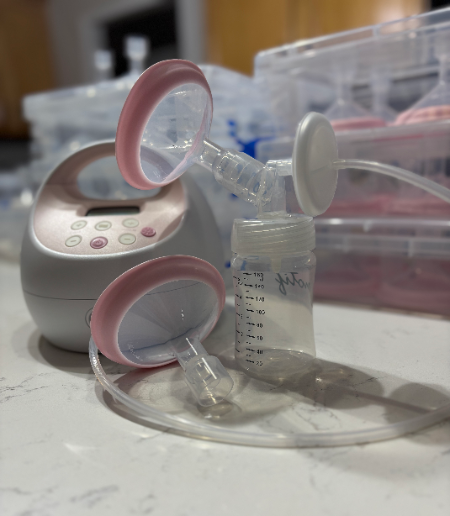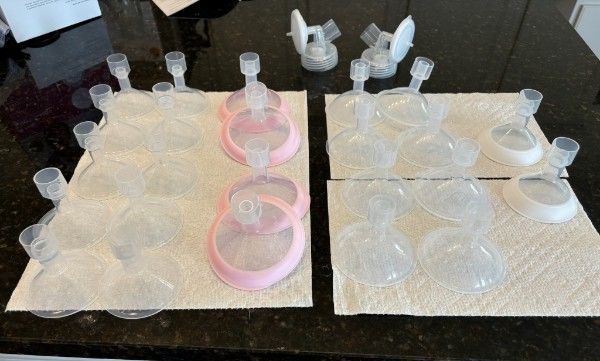Flange Sizing and Its Impact on Pumping and your Milk Supply
Why Getting the Right Fit Matters

For many new parents, pumping becomes an essential part of their breastfeeding journey. Whether you're exclusively pumping by choice, or situation (you have a premature or medically fragile baby), working, or supplementing with formula, having the right tools are important to ensure that your experience is as comfortable and efficient as possible.
One of the most important pieces of equipment you'll use is the pump flange. Most people are using a flange that is way too big for them. Pumps typically come with standard size flanges (24 mm and or 28mm). The most common size nipple during the recently published study was found to be much smaller, around 15/17mm. In our practice, the average nipple size we see is about 13/15mm.
As lactation consultants, we've seen first-hand the impact that correct flange sizing can have on both milk output, comfort and pumping session time to fully empty. Unfortunately, it’s also a very common issue that many new parents overlook. Flange sizing is not a one-size-fits-all process, and finding the right fit for your body is essential. Here's why it matters and how you can ensure you're using the correct size for your unique needs.
Why Flange Size Matters
The flange is the part of the pump that fits over your nipple during pumping. When the flange is the right size, it helps facilitate effective milk removal and minimizes the risk of pain or injury to the nipple and surrounding breast tissue. But if the flange is too small or too large, it can cause several issues, including:
- Ineffective Milk Removal: If the flange is too small, your nipple will not move freely into the tunnel and can interfere with milk flow. On the other hand, a flange that’s too large may pull too much of the areola into the tunnel, and cause compression of milk ducts and not effectively remove milk. Ineffective milk removal can lead to engorgement.
- Pain and Discomfort: A poor fit can lead to nipple pinching, chafing, swelling or bruising, making the whole pumping process feel uncomfortable. Pain can decrease the flow of hormones needed to let milk flow. Over time, this can also contribute to damaged tissue and let’s face it; nobody wants to do something if it hurts! Damage to nipples can possibly lead to mastitis, and engorgement from decreased milk removal.
- Reduced Milk Supply: When milk is not being effectively expressed, it can send signals to your body that less milk is needed, leading to a decrease in overall milk supply. This is especially concerning for parents who are pumping to build or maintain a supply.
- Emotional Impact: Pumping with an ill-fitting flange can be frustrating, painful, and discouraging. It’s important for parents to know that there are solutions to this problem.
How Do You Know If Your Flange Size Is Correct?
- Comfort: You should not feel pain or discomfort during the pumping session. You might experience a pleasurable sensation or a mild sensation of gentle tugging or pulling, or no sensation; but nothing should feel sharp, tight, stinging or “pinchy”.
- Nipple Movement: When pumping, your nipple should gently glide, while touching the sides of the tunnel. Ideally, only the nipple should be pulled into the tunnel, moving freely while the areola remains unaffected. If the nipple is not stretching or moving freely, your body may not be able to trigger a let-down. Since nipple stretching is what triggers the let-down, a lack of movement may prevent milk from flowing.
- Milk Flow: Milk should flow smoothly and steadily during pumping. You should see sprays of milk.
How do I find out what my correct size is?
Schedule a Flange fitting/Pumping consultation with us or another lactation consultant trained in flange fitting.
A flange fitting appointment includes a pumping trial using multiple shapes and sizes of flanges during a pumping session to find the optimal fit.
These sessions can be invaluable, especially if you're struggling with discomfort or low milk output. A professional fitting can also help you learn more about how to use your pump effectively, and they can help troubleshoot issues related to pumping efficiency and supply.
If you prefer to figure it things out on your own, read this
Flange FITS Guide, from Babies in Common. It comes with and explanation of how to size and fit. If you print it out there is a ruler you can use to measure your nipples.


Transitioning to the Right Flange Size
When switching flange sizes, occasionally we have parents reach out to us about a decrease in supply. While it's true that you may notice some changes in milk output during the transition, please know we can help you work through it! Here are a few reasons why changing flange sizes might affect your milk supply:
Let-Down Reflex Adjustment: Your body may have become accustomed to the sensations of the incorrect flange size, and we may need to retrain your body to respond to the new, more accurate fit.
Nipple Damage and Swelling: If the wrong flange size caused nipple damage or swelling, the discomfort could interfere with milk flow, making the transition to a new size feel challenging at first.
Residual Swelling from an Overly Large Flange: If your previous flange was too large, it might have caused swelling that masked your true nipple size. In this case, the new flange size might not feel quite right initially, and we'll need to address the swelling before achieving optimal results.
The more significant the change in flange size or the greater the damage caused by the previous fit, the higher the likelihood of encountering some challenges.
If your new flanges hurt, please contact your lactation consultant!
If they feel comfortable, but you're not getting the same milk output as you did before we recommend a switch out method or retrain method. Try each method below and see what works best. Keep in mind that this phase is temporary and your body will adjust!
Retrain Method
Use the new flange on one breast and the old flange on the other. Alternate which breast gets the new flange at each pumping session until your body adjusts. This method is especially effective if the old flange size wasn't causing pain or damage.
Switch Out Method
Start by using the new flange sizes for 10-15 minutes, then switch to the old flanges to finish emptying the breast. Gradually increase the time with the new flanges and decreasing the time with the old ones. It might take up to 2 weeks to fully adjust, but most people experience improvements in 2-3 days.
Final Thoughts
Getting the right flange size is essential to your comfort and protecting/increasing your milk supply. While flange size may seem like a minor detail, it can make a big difference in your overall pumping experience. If you’re unsure about your flange size or experiencing discomfort, don’t hesitate to reach out to us. Your pumping/feeding journey is a marathon, not a sprint, and every step you take toward comfort and efficiency matters. You and your baby deserve the best start, and that includes setting yourself up for pumping success.
References
Anders LA, Mesite Frem J, McCoy TP. Flange Size Matters: A Comparative Pilot Study of the Flange FITSTM Guide Versus Traditional Sizing Methods. J Hum Lact. 2024 Nov 30:8903344241296036. doi: 10.1177/08903344241296036. Epub ahead of print. PMID: 39614713.
Infant and Young Child Feeding: Model Chapter for Textbooks for Medical Students and Allied Health Professionals. Geneva: World Health Organization; 2009. SESSION 2, The physiological basis of breastfeeding. Available from: https://www.ncbi.nlm.nih.gov/books/NBK148970/


